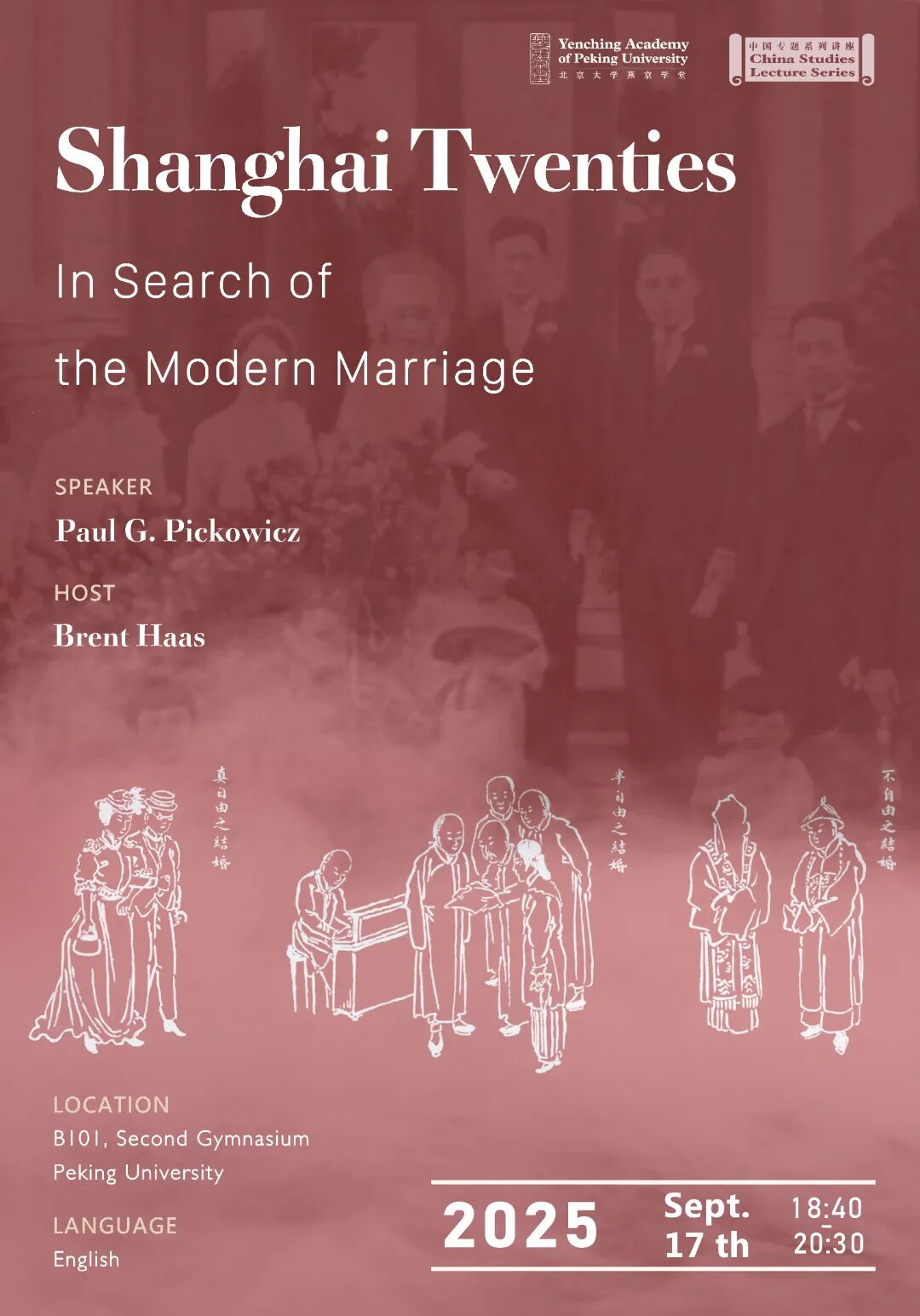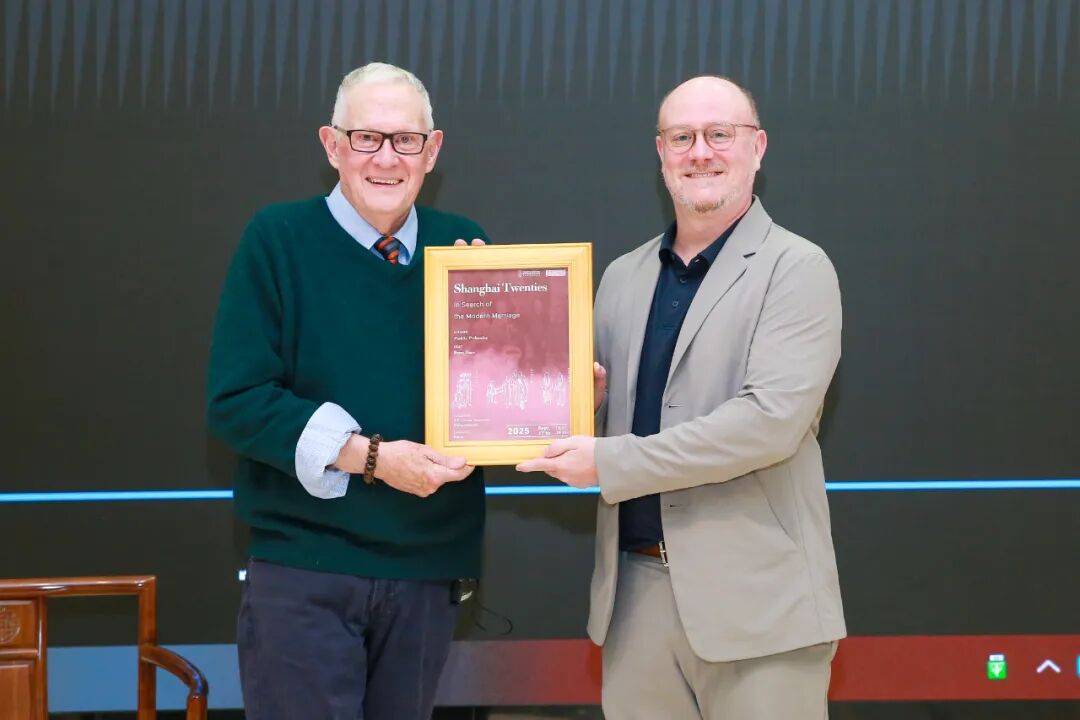On September 17, Paul G. Pickowicz, Distinguished Professor Emeritus of History at the University of California, San Diego, delivered a lecture titled “Shanghai Twenties: In Search of the Modern Marriage” at the Yenching Academy. It was the second lecture in our Topics in China Studies Lecture Series for the 2025‒26 academic year, hosted by YCA Associate Dean Brent Haas.

Interview Notes
Prior to the lecture, Prof Pickowicz had an interview with us. He first highlighted the important role of interdisciplinary methodologies in pushing forward the limits of conventional regional studies. Prof Pickowicz has engaged in the field of history since his university years. He made his first trip to China in 1971, since when he dedicated himself to focusing on “what’s going on” in Chinese society, by adopting interdisciplinary approaches, including sociology, anthropology, and political science. The professor prefers not to be confined to one discipline or another; instead, he chooses methodologies that suit what he is working on. He has conducted village research and field research and talked to film workers, exploring the connectivity between history and the present. The interdisciplinary approach that connects the past and the present enables him to see China from diverse perspectives and to place the country in a global context.
The professor then talked about the issue of modern marriage presented in the films made in 1920s Shanghai, such as the three he would examine in the lecture: A String of Pearls (1925), Oceans of Passion, Heavy Kissing (1928), and Orphan in the Snow (1929). The young people living in cities back then were perplexed about what “modern marriages” were: They pursued romance and love, and they were against arranged marriages. But no one knew what “a modern marriage” truly meant. The issue remains in discussion around the world today. Prof Pickowicz noted that Chinese society is undergoing the same dilemma: Women may prefer professional success to marriage, which disagrees with the nation’s population policy trend and traditional concept of family. And China is not alone. Japan, South Korea and many other countries are facing the same situation. History and reality converge at this point, that is, the issue of what modern marriage is, raised in films 100 years ago, is still seen in the present-day society.
Prof Pickowicz strongly recommended the 1934 film Shennü (The Goddess), directed by Wu Yonggang, to our Scholars. Starring Ruan Lingyu, the film tells the story of a prostitute who struggles to raise her son in Shanghai, and is an artwork that challenges the deep-rooted stigmatisation of prostitutes. Prof Pickowicz noted that Shennü, through its framework of narrative and image, creates a kind of “politics of shaming”. It urges the middle-class audience to reflect on their established prejudice against prostitutes and to rethink what is moral and what dignity means. The protagonist of the film is a prostitute, but she is “a model human being” and a mother devoted to her son. In contrast, the middle-class characters in the film are cold-hearted hypocrites. The film reveals the complicated relationship between man and woman and between different classes. The professor also pointed out that Ruan Lingyu committed suicide due to tabloid slanders, showcasing the connection between the characters she’d played and her personal life tragedy. Prof Pickowicz considered the film Shennü as a window on social views, women’s fate, and history of modern Chinese culture.
Review of the Lecture
Prof Pickowicz noted that between 1920 and 1929 China produced about 500 films in total, most of them made in Shanghai. However, only 18 have survived, with merely eight preserved in their entirety. His lecture centered on three of the surviving films: A String of Pearls (1925), Oceans of Passion, Heavy Kissing (1928), and Orphan in the Snow (1929).

The professor first conducted a historical examination of the common features of the three films, which unveiled important aspects of the social and cultural life in 1920s China. First, all the three were products of popular culture targeting the middle-class audience. They belonged neither to high art nor to vulgar art. The films appealed to a very broad audience, as indicated by the archival data, such as admissions, screenings, and length of release. Secondly, all the three films, like many others of the time, told stories of people living in a large city. And thirdly, all three explored the issue of modernity, particularly social and cultural modernity.

Moreover, the screenwriters and directors of the three films were all men from an urban background who interestingly tried to tell stories of women in the city and explore modern marriages. The “rejection of arranged marriages” stood at the core of the Chinese understanding of “modern marriage” 100 years ago, and this was also the need expressed by the protagonists. All the plots revolved around the rejection of arranged marriages and tried to answer questions such as “What is a modern marriage?” “Where is the boundary?” “What crosses the boundary? What doesn’t?” “How to we judge a transgression?” But all the questions remained unanswered at the time. As a result, the couples in the three films didn’t know what a “modern marriage” was, even though they desired it. This is what makes the films so interesting; they reveal people’s experimentation and exploration within the framework of “modern marriage”.

Prof Pickowicz introduced to our Scholars the three “modern couples” in the films: Xiuzhen and her husband Yusheng in A String of Pearls; Lijun and her husband Qiping in Oceans of Passion, Heavy Kissing, and Chunmei and Dapeng in Orphan in the Snow. The major tension in all three films lies in the dissatisfaction of the modern women with their “modern marriages”; that is, they seemed to want more, or specifically, they wanted a more satisfying modern marriage and relationship. Xiuzhen felt her material needs unmet; Lijun had unfulfilled desires; and Chunmei struggled to break through the class ceiling. In addition, we can see a clear process of modern marriage in the three films, i.e. the five-stage process of modern marriage that Prof Pickowicz put forth in his work China on Film: Temptation, Transgression, Negotiations, Redemption, and Submission (submission of wife to her husband in a modern sense). The three films followed this five-stage process in plots centered around their female protagonists. During the lecture, Prof Pickowicz played key clips from the films, illustrating how the five-stages was tightly woven into the narratives.

Prof Pickowicz noted that the first four of the five stages were well illustrated in the three films, indicating possibilities of the modern marriage back at the time; yet, the fifth stage (submission) was disappointing, and none of the three films were spared from the pattern. It was a violation of what the “modern marriage” claimed to be. One possible explanation is that the male writer-directors were not as socially progressive as one might think. The three films raised the issues of concern and put women at the center of narrative; however, the husband’s expectation of submission from the wife remained the underlying message, without exception. The professor’s interpretation was thought-provoking: The modern marriage seemed to be progressive in the 1920s, because it called for the untraditional “free marriage” and rejected the arranged marriage. However, the “modern marriage” concept at the time never truly addressed gender equality. In fact, the “submission” presented on the silver screen aligned with the “progressive” ideas prevailing at the time, and it was not inconsistent with the then-dominant notion of “modernity”.

Furthermore, the “submission” presented in the Chinese films fitted in the worldwide “modernity” of the 1920s. Under the influence of the prevailing Victorian values, the heroines in the three films were modern women in the modern marriage, but with no occupational skills, they depended upon the husband for support. The phenomenon was also seen in the middle-class modern marriages in New York and London. What was projected on the Chinese silver screen was no different from its global counterparts: In the 1920s, modern marriages in London and Shanghai alike faced the same dilemma. Moreover, the American women’s suffrage movement achieved success in the 1920s, securing the right to vote for women. In contrast, women, in Switzerland, a widely recognised modern, progressive nation, had only been granted the right to vote until 1971. Therefore, the limited understanding of the modern marriage presented in Chinese films must not be examined in the Chinese context alone; instead, it should be explored against a global backdrop.
At the end of his lecture, Prof Pickowicz stressed that the films made 100 years ago are still relevant today, as many of the issues remain under discussion, such as the global concern for genuine gender equality.

Q&A Session
Q: I find both Chinese and English were used in the films. Does it indicate an acceptance of Anglo-American and European cultures in 1920s’ China? What do you think about the mix of Chinese and English lines in the films?
A: Foreign communities were large size in Shanghai during the 1920s and 30s. Some may think that the films used a mix of Chinese and English lines to attract a foreign audience who didn’t know Chinese or couldn’t read Chinese subtitles. But that was not the true reason. The true reason was unexpected: early Chinese filmmakers were already aiming at an overseas market for their films. The targeted audience were overseas Chinese in Southeast Asia, such as Myanmar, Thailand, and the Philippines, where overseas Chinese communities were concentrated. The Chinese immigrants of the 18th and 19th centuries mainly spoke the Hakka and other dialects. Their descendants may speak Chinese, but could not to read Chinese subtitles. In countries like Singapore, English was widely used. So the mix of Chinese and English lines in the films was meant to attract English-speaking, younger-generation overseas Chinese who could not read Chinese.
Q: You just mentioned that Ellen Key and A Doll’s House were frequently seen in the 1920’s films made in Japan and Japanese colonies. In Shanghai back then, were there discussions over similar Western playwrights and works? Did such Western works have impacts on the discussion over man-women relationships in Shanghai? Or, were the discussions in Shanghai under other influences?
A: “Modernity” is evolving. It originated in Europe and was brought to every corner of the world, having impacts on Japan, China and many other nations. The world at the time was dominated by colonial empires, and it was easy to access modern foreign cultures, as I just mentioned. In the 1920s, cinemas in Shanghai played more Hollywood films than films made in China and the audience were mainly Chinese. One theme or another in the imported literary works and films alike may have struck a chord with the Chinese readership and audience, because Shanghai itself was undergoing the transition to modernity and people living in the city could see the connection between their life and global themes and trends. That’s why I see no fundamental differences between the issues raised in films made in Shanghai, or London, or Tokyo. It’s not the issue of antagonism between the East and the West; it’s an issue of metropolis.

